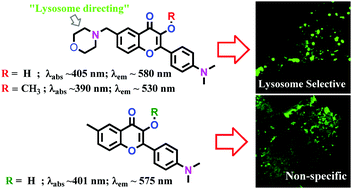A fluorescent flavonoid for lysosome detection in live cells under “wash free” conditions†
Abstract
Lysosomes are vital organelles in living cells, which have acidic environments (pH 4.0–5.0) where macrobiomolecules and malfunctioning organelles are broken down into monomers by hydrolase activity. The majority of the currently reported fluorescent probes for detecting lysosomes suffer from small Stokes shifts (Δλ < 20 nm) and higher cytotoxicity due to an “alkalinizing effect”. An interesting flavonoid-based lysosome probe is synthesized by introducing a morpholine moiety onto the flavonoid skeleton. This new probe has shown excellent selectivity to detect lysosomes in MO3.13 oligodendrocytes and normal human lung fibroblast cell lines. Probes 1a and 1b have shown excellent fluorescence quantum yield (ϕfl up to 0.43 in non-aqueous solvents) and large Stokes shifts (120–150 nm). These new fluorescent probes also exhibit a large quantum yield difference from an aqueous to organic environment, making them potentially useful as “wash-free” stains for visualizing lysosomes. Cell viability evaluation of these probes shows excellent biocompatibility with the median lethal concentration being LC50 ≈ 50 μM.



 Please wait while we load your content...
Please wait while we load your content...